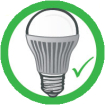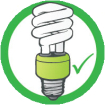LED Lamps have been increasingly used for lighting purpose in recent years.

CFL has been included in the Mandatory Energy Efficienty Labelling Scheme.

| 1. | What is the reason to phase out ILB? |
|---|---|
| ILB is energy-inefficient. There is a general international consensus to phase out ILB for the purpose of energy conservation, energy efficiency and reduction on emission of greenhouse gases. | |
| 2. | What is the scope of ILB targeted in the Energy Saving Charter? |
| The targeted ILB is identical to the ILB included in the public consultation in August 2011, which includes non-reflector type ILB of 25 watt (W) or above, which operates at a single phase electricity supply of nominal voltage of 220 volts (V) including General Lighting Service lamps, candle shape, fancy round and other decorative lamps, but excluding tungsten halogen lamps. The targeted ILB is highly energy-inefficient. There are already sufficient replacement options and there is a strong economic case for using more energy-efficient lamps. | |
| 3. | How much energy can be saved by energy-efficient light bulbs? |
| If we replace the targeted ILB by energy-efficient lighting, it is estimated that there is an electricity saving of up to 390GWh per annum for the community as a whole. For example, Compact fluorescent lamps (CFL) save around 75% of electricity compared to ILB. A household of four persons could save up to $440 in electricity bill each year by replacing ILB with energy-efficient CFL assuming an average tariff of HK$1 per kWh. | |
| 4. | What are the replacement options for ILB and how to improve energy efficiency for lighting? |
| Non-reflector type ILB can by large be replaced by more energy-efficient types of lamps, such as CFL etc. Light Emitting Diode (LED) lighting technology is rapidly developing in recent years, and has potential to be an alternative form of energy-efficient lighting. The Government launched a Voluntary Energy Efficiency Labelling Scheme for LED Lamp in June 2011. | |
| 5. | Questions on disposal of spent CFL generated from households |
| Please refer to "Fluorescent Lamp Recycling Programme". |
Common types of ILB can be replaced by energy-efficient light bulbs readily available in the market:

